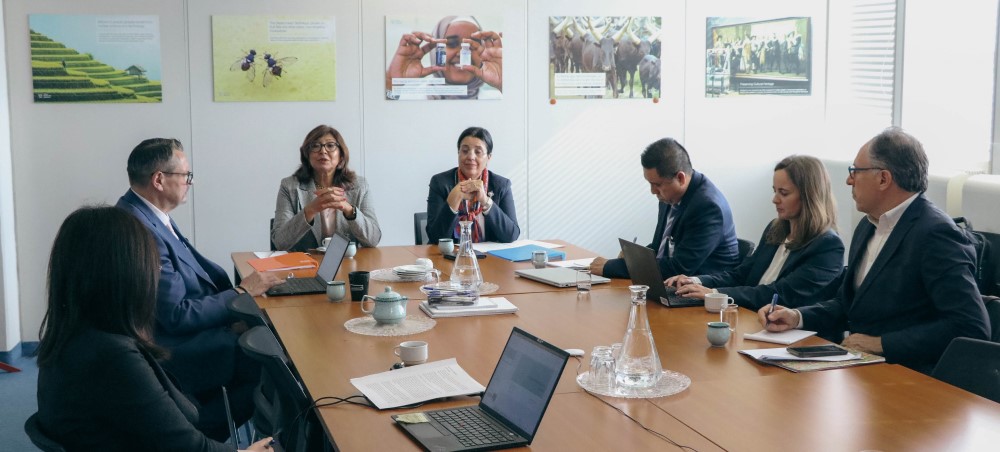Steering the FAO IAEA partnership into the future

©FAO/Matteo Casling
Earlier this month, the 22nd Meeting of the Joint FAO/IAEA Centre Steering Committee took place at IAEA headquarters in Vienna under the leadership of IAEA Deputy Director-General. Head of the Department of Nuclear Sciences and Applications Najat Mokhtar, FAO Deputy Director-General Maria Helena Semedo and FAO Assistant Director-General Beth Crawford.
Joined by key representatives from both Organizations, discussions focussed on progress, priorities and future plans. “Our close collaboration has enabled us to support Member States with valuable technology, policy advice and unique know-how. The innovative solutions we offer leverage the potential of nuclear applications in food and agriculture to help combat food security, climate and biodiversity challenges and move closer to achieving the 2030 Agenda for Sustainable Development,” said Semedo. Highlighting successes, she added: “our partnership has provided the world with game-changing technology from radiation-induced genetic plant diversity to rapid space-breeding of wheat, barley and sorghum.”

FAO, IAEA and Joint FAO/IAEA Centre management participating in the 22nd Joint FAO/IAEA Centre Steering Committee. From the left, Dongxin Feng, Officer in Charge for Day-to-Day Matters of the joint FAO/IAEA Centre. Jean Pierre Cayol, Departmental Programme Coordinator. FAO DDG Maria Helena M.Q. Semedo, IAEA DDG Najat Mokhtar, Tiensin Thanawat, Director of the Animal production and Health Division, Anne Bogdanski, Technical Office. Reza Najib, Programme Support Officer. @IAEA/J. Murickananickel
Underlining the impact of the Joint Centre’s work, IAEA’s DDG Mokhtar said: “Through the Joint Centre, we currently run more than 25 coordinated research projects involving some 400 research institutions and experimental stations, and we provide capacity-building and technology transfer to over 200 national and regional IAEA technical cooperation projects as well as technical and policy advice to decision-makers. Our vast research and development shows how nuclear applications offer added-value to conventional approaches in tackling today’s agricultural challenges.”
Dongxin Feng, Officer in Charge for Day-to-Day Matters of the Joint FAO/IAEA Centre, presented an overview of achievements during 2023 and an outlook for 2024 and beyond, including future R&D and technical cooperation, establishing new partnerships and enhancing communication and outreach.
To bolster the groundbreaking flagship Atoms4Food Initiative launched by both organizations in October 2023, meeting explored how to strengthen a more coordinated approach to agrifood systems transformation for demand-based research prioritization, integrated management practices, robust technology delivery, innovation, and knowledge management. by harnessing the advantages of nuclear techniques along with conventional and advanced technologies. An Atoms4food Roadmap elaborating the initiative’s vision, theory of change, guiding principles, priority actions and implementation strategy will soon be released.
Revolutionizing research
The delegation also visited the FAO/IAEA Agriculture & Biotechnology Laboratories in Seibersdorf. These unique labs represent an integral part of the Joint FAO/IAEA Centre, performing applied and adaptive research and development focused on the application of nuclear and related techniques in food and agriculture in five key working areas:
- Animal Production and Health
- Food Safety and Control
- Insect Pest Control
- Plant Breeding and Genetics
- Soil and Water Management and Crop Nutrition
The specialised laboratories, supported by their respective section in headquarters, develops practical solutions and empower scientists from Member States through targeted R&D, training programmes and the sustainable transfer of knowledge and expertise to Member States, equipping them to address agricultural challenges.
From Joint Vision to Global Impact – Celebrating 60 Years of Solutions
2024 marks the 60th anniversary of the Joint FAO/IAEA Centre. Recognizing evolving world challenges, in 1964 the FAO and IAEA merged forces to establish the then Joint FAO/IAEA Division of Isotope and Radiation Applications of Atomic Energy for Food and Agricultural Development to help Member States apply peaceful nuclear techniques to strengthen food and agricultural needs. The Joint Centre has been supporting countries ever since by leveraging innovative research and development to generate high-impact application of peaceful nuclear and related techniques in food and agriculture. With its strengthened partnership, the Joint Centre plays an increasingly important role in shaping international strategies for achieving food security and sustainable agricultural practices.
Events are planned to highlight the achievements of the Joint FAO/IAEA Centre and to celebrate this unique entity within the UN system demonstrating the enduring power of interagency collaboration in tackling global food security challenges.
